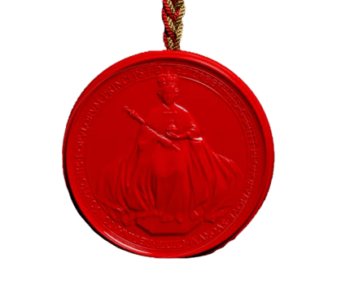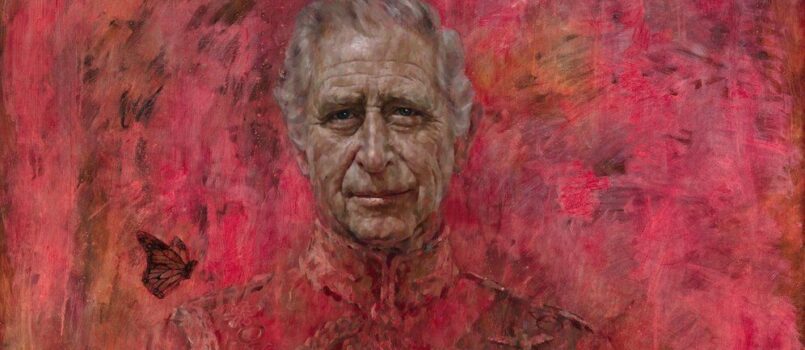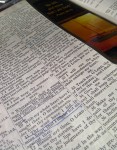A couple thoughts on what has just transpired regarding the unveiling of Charle’s portrait. I’ve been seeing a fair bit about this recently, and CTV ran an article on it themselves. According to one source, Charles flinched a moment as he pulled down the curtain! According to CTV’s article, this portrait had been commissioned to commemorate his 50+yrs with The Draper Company, a 650yr old corporate establishment.
1) Even if all the splotches across the painting weren’t there, even if said splotches didn’t match up if reflected in certain ways to show certain dark spiritual entities, the impression many have of a fiery portrait, or that others have of a bloody portrait (not the British slang use here), is reason enough to warrant flinching. The fact that literally ONLY the face is of any normal colouration is enough to warrant concerns over what this painting is trying to say about it’s subject. The artist claimed inspiration from the uniform that was worn in his colour choices, but I’ve seen other illustrations where colours were pulled or inspired from an item in the image, that didn’t give the unnerving, unsettling, ominous tone that this one does.
2) A review of The Draper Company’s history suggests that not only was this company influential in it’s original role as a wool seller’s guild way back in the 1300’s, but that it was also incredibly influential in London, England politics! One might say that on a municipal level, it historically, was as influential as the masons are now, though masonry doesn’t stop at municipal influence, it goes all the way up the political chain whereever it can. Unlike masonry, The Draper Company claimed religious affiliation with the church, choosing a patron saint, etc. It appears that as the years, decades and centuries went by, that it became a matter of status and prestige to be a member of The Draper Company even if you weren’t a seller of wool or textiles.
They eventually moved away from their wool sellers guild origins to focus on philanthropy for the less fortunate among their own ranks and eventually to the larger city itself. They funded various initiatives from housing to food to clothing needs to education, and according to their website, still do. In 1870, their educational focus included technology training that carries on to this day. They started schools, universities, etc.
Apparently Queen Elizabeth ll was a member and was celebrated for 70 years of service in 2014. Now here is Charles, her son, being celebrated for 50 years of service.
 3) While everyone is talking about how eery the new portrait is, The Drapers Company historical timeline on their website, shows another blood red image with a note from 2008 when their royal charter received some amendments. This image appears to be a coin or seal on a multi-coloured string or rope (can’t tell size due to nothing to compare to in the image). The depiction is of Queen Elizabeth ll on her throne, but the whole coin or seal is a shiny blood red!
3) While everyone is talking about how eery the new portrait is, The Drapers Company historical timeline on their website, shows another blood red image with a note from 2008 when their royal charter received some amendments. This image appears to be a coin or seal on a multi-coloured string or rope (can’t tell size due to nothing to compare to in the image). The depiction is of Queen Elizabeth ll on her throne, but the whole coin or seal is a shiny blood red!
4) This red colour. . . is it really from the Welsh regiment Charles was honourary general of? Does it stem from a royal protocol I am not familiar with? I am not a royal watcher, so I could be out of the loop on this. Or is the red colour a symbol related to The Draper Company somehow? Why red?! And why blood red at that?!
Why do I get the feeling that a message has been sent in the mere act of unveiling this portrait? Who is the message for? I know the colour red has symbolic meaning in the higher ranks of the masonic lodge. I know it has meaning in the church, and I know it has meaning in satanic circles as well. However, I don’t think the message is directed at the church! The overall sense of the portrait doesn’t offer the peace that comes from salvation found in Christ Who shed His blood for our sins. Instead, there seems to be an ominous nature about the image, and the colour’s presentation in particular with it’s splotchy appearance. One commenter on an Infowars article likened the image to being a scene from hell, as if Charles were standing in hell.
Whoever the message is for, did Charles agree to this presentation? If so, why did he flinch when he unveiled it? Or should he be looking over his shoulder after seeing this depiction of himself? If the portrait wasn’t supposed to be this eery, I hope the artist is rebuked and a new portrait by a different artist is commissioned to replace this depiction.
5) Art is highly emotional and used in various ways to influence the public, and yes, even to send messages to those who look closely enough. Sometimes an artist just liked a thing and didn’t intend any hidden message at all and is either dumbfounded or aghast at what the public saw in their work. If this artist is aghast at what the public sees, was the artist told to paint in this manner, or was it personal preference to paint in this manner as he says in the CTV article? I hope he’s not covering for someone at The Draper Company, because this is not a good portrait in the slightest!



